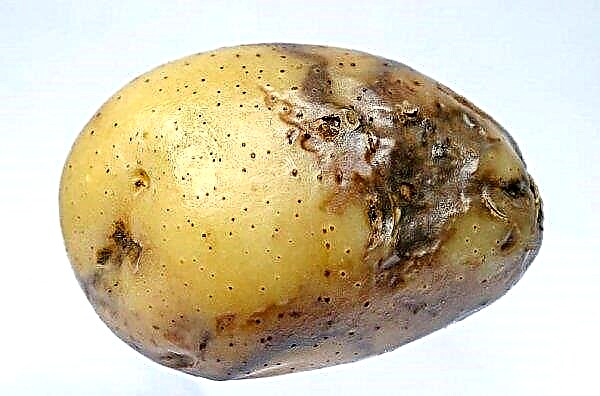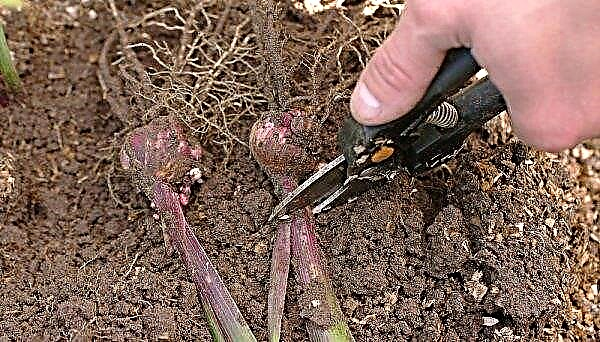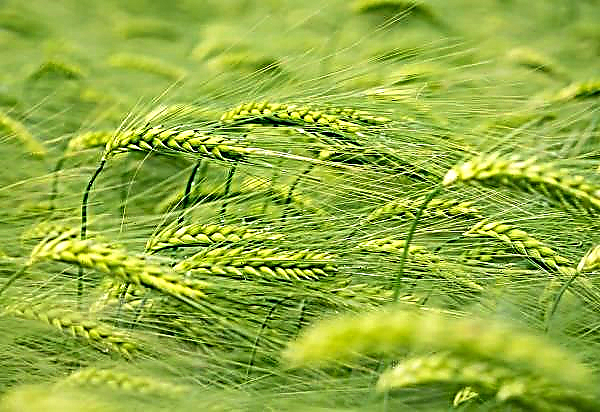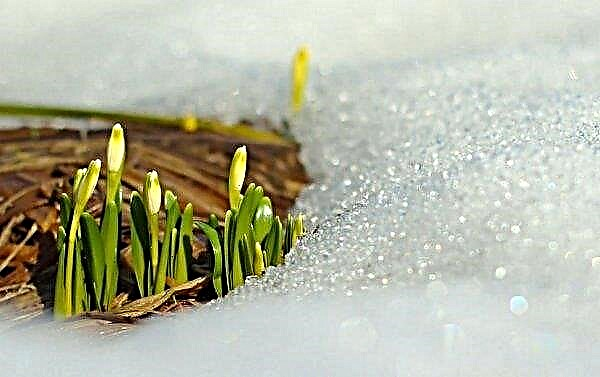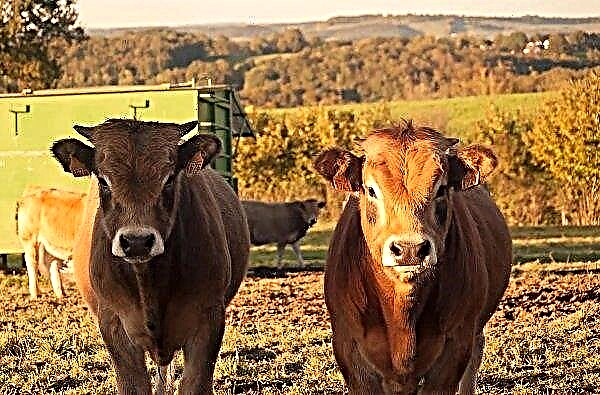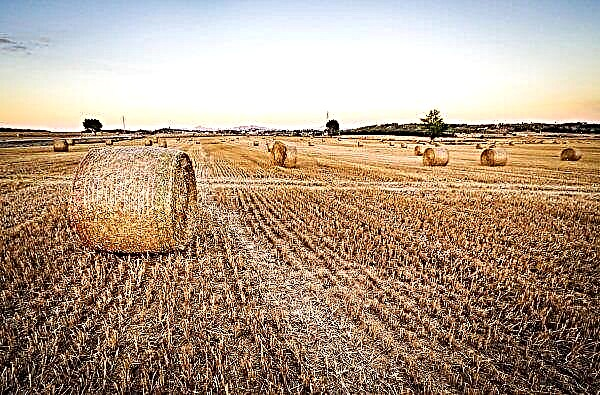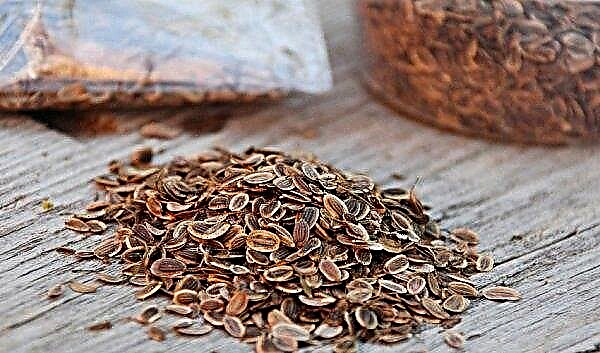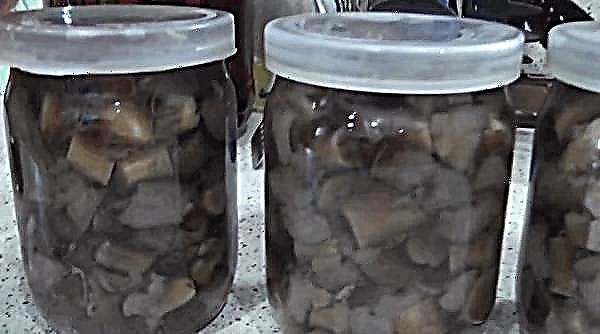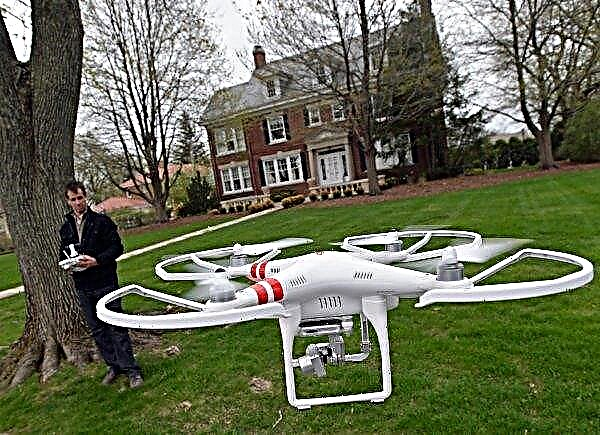Many flower growers love to grow evergreen shrubs at home, the brightest representative of which is Dieffenbachia spotted. Although this plant is native to South America, it is often grown indoors. In this article, we will consider the description of spotted dieffenbachia, the conditions for its cultivation and reproduction, as well as the rules of care.
Botanical description of the plant
Spotted Dieffenbachia in all the photos looks like a relatively large shrub with spotty leaves, which gave the name to this species of plant. The length of its leaves can reach 1 m with a width of 12 cm. They grow one at a time on long stems extending from the main trunk. With good care, a new sheet appears every week. The flower grows quickly to a height of 1 m with good care. The stem usually grows only in height, but sometimes branching can also form near the base of the lateral shoots. The period of active growth falls on spring and summer. From the beginning of autumn to the end of winter, the plant is at rest. Most often, the plant blooms in the second half of spring, but in indoor conditions it blooms very rarely. Large white or beige inflorescences are similar in shape to corn cobs and can reach 18 cm in length. Outside, they are covered with a long green leaf - bract. The flowers of the plant are divided into male and female. The lower part of female inflorescences as if wrapped in a bract. After flowering on Dieffenbachia, small juicy orange-red berries are formed, inside which black seeds are contained.
Most often, the plant blooms in the second half of spring, but in indoor conditions it blooms very rarely. Large white or beige inflorescences are similar in shape to corn cobs and can reach 18 cm in length. Outside, they are covered with a long green leaf - bract. The flowers of the plant are divided into male and female. The lower part of female inflorescences as if wrapped in a bract. After flowering on Dieffenbachia, small juicy orange-red berries are formed, inside which black seeds are contained.
Did you know? Dieffenbachia got its name in honor of Joseph Dieffenbach, the senior gardener of the imperial gardens in Vienna, who lived in the XVIII century.
| Root system | Powerful, branched |
| Stem | Thick, massive |
| Leaf shape | Oblong, oval, pointed |
| Leaf color | Green with white spots or stripes |
| Flower shape | In the form of a cob |
| Flower color | White beige |
| Fruit shape | Oval |
| Fruit color | Orange red |
| The taste of fruit | The fruits are poisonous, you can’t eat them. |
Benefit and harm
Dieffenbachia spotted is a poisonous plant. Her indoor species are less toxic, although they require compliance with certain security measures.
- Despite this, Dieffenbachia has the following advantages:
- absorbs toxins contained in the air;
- reduces the amount of dust in the room, works well for people with allergies;
- absorbs harmful bacteria in the air.
Dieffenbachia spotted juice is dangerous for the human body.
- It can cause such negative consequences:
- irritation, swelling, and loss of sensation on contact with skin;
- swelling of the tongue and disturbances in the work of the vocal cords in contact with the mucous membranes of the oral cavity;
- serious food poisoning if ingested.
Conditions for successful growing at home
Many gardeners consider Dieffenbachia spotted as a capricious and demanding plant, but this is not entirely true. The flower does not respond well to cold, drafts and too dry air. Otherwise, it does not require specific growing conditions.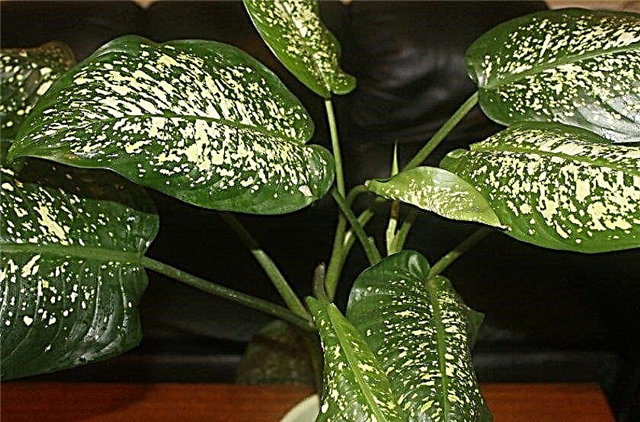
Accommodation
The plant can be placed on the floor or on the windowsill, in a place protected from drafts, well-lit, but not in direct sunlight. Lighting should be bright and diffused. A flower pot can be positioned two meters from a well-lit window. When the street is cloudy, you need to turn on artificial lighting, otherwise the spotted leaves of Dieffenbachia will turn pale and lose their beauty.
Important! Prolonged flowering greatly weakens Dieffenbachia and worsens its appearance. To maintain decorativeness, it is recommended to cut off the resulting inflorescences.
Temperature mode
The flower does not tolerate low temperatures. In the summer, the room is maintained at a temperature of +20 ... + 30 ° C. During this period, the plant can also be taken out to the balcony or porch. The main thing: do not leave it in direct sunlight, so as not to provoke the appearance of sunburn on the leaves. In winter, the room temperature should not fall below + 18 ° C. Dieffenbachia is contraindicated in drafts and sudden changes in temperature. They can cause leaf dropping.
Air humidity
The flower does not tolerate dry stagnant air, so the room must be ventilated. Optimum for dieffenbachia is air with a humidity index of 70–80%. In summer, and when growing in a warm room and in winter, you need to regularly spray the leaves of the plant with water. To remove dust and improve appearance every 10-14 days, the leaves of the flower are wiped with a damp cloth.
Did you know? Centuries ago, in the West Indies, slaveholders punished slaves by forcing them to bite the stem of Dieffenbachia. This caused severe swelling of the tongue and robbed a person of speech.
Home Care
Dieffenbachia spotted requires minimal home care. One of the main factors on which the normal growth and development of a flower depends is the correct regime of watering, fertilizing, pruning and transplanting a plant.
Watering
For watering and spraying the flower, you need to use either boiled or previously defended water. It should not be cold, even in summer dieffenbachia is watered with water at room temperature. Normal water from the water supply contains lime, which is contraindicated in spotted dieffenbachia, so this water must be filtered before irrigation. If possible, you can also collect rainwater and water the plant with it.
The rules for watering Dieffenbachia on a spotty summer are as follows:
- the flower needs a lot of water, so you need to water it abundantly, but do not turn the soil into dirt;
- Dieffenbachia is watered as soon as the topsoil in the pot becomes dry;
- the leaves of the flower are sprayed with water and wiped from dust for a beautiful shine;
- You can briefly put Dieffenbachia under a warm shower, while covering the earth in a pot so that it does not become too wet and does not provoke root rot.
In autumn and winter, Dieffenbachia is at rest, so it is watered during this period according to the following rules:
- the flower is watered when the topsoil has dried 2-3 cm deep;
- if the room is cool, the plant is watered less often;
- leaves can be sprayed only if the flower is kept at a temperature of at least + 22 ° C.
Important! The soil around the stem of Dieffenbachia must not be completely dry, otherwise the plant will die.
Top dressing
Fertilizers are applied only from March to August. At this time, there is a phase of active growth of spotted dieffenbachia and it needs nutrients. Feeding with mineral fertilizers is carried out 1 time in 20 days. To do this, use only those fertilizers that do not contain lime. The solution should have a concentration of 2 times less than that indicated as recommended. Organic fertilizers also need to be applied during the growing season of the flower with a frequency of once every two weeks. They should not contain a lot of nitrogen - it will accelerate the growth of the plant, but can make the leaves green, eliminating the beautiful pattern of white spots and stripes.
Pruning
The higher the spotted Dieffenbachia grows, the fewer leaves remain on the lower part of its trunk. As a result, the appearance of the flower worsens and the stem has to be cut and rooted in a new pot. Leaves on the trunk of Dieffenbachia are cut off only if they are damaged or dried.
Pruning a plant should be done carefully, following these recommendations:
- Gently pat the damaged leaf or trunk of a flower with a napkin that absorbs poisonous juice.
- To disinfect a knife in alcohol solution.
- Carefully cut the desired section of the trunk or stem of the leaf and blot the cut off place with a napkin.
- Sprinkle the slice with powdered activated carbon.
Important! To avoid getting the poisonous juice of Dieffenbachia on the skin of the hands, pruning of the plant should always be done with tight rubber gloves. Through ordinary medical gloves, poison can seep onto the skin of the hands.
Transfer
It is recommended to transplant spotted dieffenbachia from the end of February to the beginning of May. Transplantation is carried out as necessary, when the plant becomes crowded in an old flowerpot. Sometimes the roots of Dieffenbachia can completely fill a new pot in 5-6 months. In this case, the transplant is carried out 2 times a year. The new pot should be a couple of centimeters larger in diameter than the old one. In its bottom there must be drainage holes for draining excess water. The flower needs a moist and loose soil with weak acidity.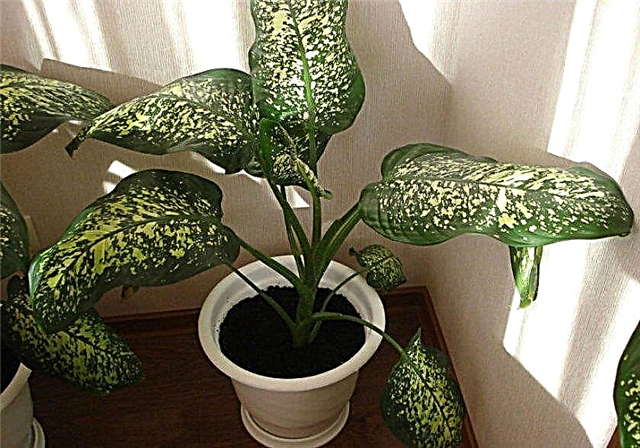
The soil in the pot should consist of the following components:
- sheet land - 45%;
- peat - 22%;
- crushed sphagnum - 22%;
- sand - 11%.
Consider the basic rules of dieffenbachia transplant:
- Lay a thick drainage layer in a new pot.
- Carefully remove dieffenbachia from the old pot with an earthen lump formed around the root.
- To clear the soil stuck on the roots from pieces of old drainage and transfer the flower to a new flowerpot.
- Pour the roots of the plant on top of the prepared soil.
Video: Dieffenbachia spotted transplant
Breeding
The plant can be propagated by stem and apical cuttings, as well as seeds. The first method of propagation is quite simple and is used to grow a new plant of the same variety. The second method of propagation is rarely used and mainly for the purpose of breeding new varieties of flower. Propagation of Dieffenbachia by any of the above methods can be carried out at any time of the year.
Important! While working with the plant, you should not touch your face with your hands so that the poisonous juice of Dieffenbachia does not accidentally get into the eyes or on the mucous membranes of the oral cavity. If the juice still got on the skin or in the eyes, then you need to rinse it with plenty of running water.
Cuttings
The propagation of spotted dieffenbachia can be carried out by cutting the apical or stem cuttings. The top of the plant is cut off when the flower has reached a high height and the lower part of its trunk is left without leaves.
The rules for trimming and rooting the apical cuttings are described below:
- Carefully cut off the top of the plant on which the leaves are located.
- Blot the cut of the handle with a napkin and put it in warm water.
- Keep the stem at a temperature of +21 ... + 24 ° С under diffused bright lighting.
- Spray leaves and stem regularly with water.
- Wait for roots 2-3 cm long.
- Remove the rooted stem from the water and place it in a pot of soil.
Important! To root the top, you can immediately place it in moist soil, consisting of a mixture of sand and peat, and after the roots appear, transplant it into an individual flowerpot.
The dieffenbachia trunk remaining after trimming the top with leaves can be used for propagation by stem cuttings.
Details of the process are described below:
- Trunk the flower at a height of 10 cm from the surface of the soil. The cut piece is also cut into several cuttings, leaving at least one knot on each of them.
- Dry the resulting pieces at room temperature for 1-2 days.
- Lay the cuttings horizontally on a moistened mixture of peat and sand. Stretch a transparent film over them and hold the container at a temperature of + 25 ° С until the formation of roots.
- Transplant rooted cuttings into permanent flowerpots.
The piece of the old Dieffenbachia trunk with the root remaining after trimming all the indicated parts can be left in the old pot and watered as the earth dries. After a few days, a new shoot will appear on the top of the hemp. As soon as 2-3 leaves appear on a new sprout, it is cut off and transplanted into a separate container for rooting.
Video: propagation of dieffenbachia spotted by cuttings
Seeds
Propagation of dieffenbachia spotted by seeds is usually carried out only by professional breeders, with the aim of breeding new varieties of plants. This method of reproduction requires much more time and is possible only when the plant blooms. In order for the flowers to give an ovary of fruits, from which later it will be possible to collect seeds for propagation, they must be pollinated artificially. To do this, a longitudinal incision is made along the female inflorescences on the leaf that covers them. Brush collect pollen from male flowers and apply it along the incision on female flowers. Then the incision is carefully sealed with tape, and a plastic bag is put on the cob until the end of flowering.
Did you know? Centuries ago, in the West Indies, slaveholders punished slaves by forcing them to bite the stem of Dieffenbachia. This caused severe swelling of the tongue and robbed a person of speech.
After a few days, the plant fades and the inflorescence dries up, and in its place the fruits form. They ripen within 5-6 months, forming black seeds inside. When the peel on the surface of the fruit becomes wrinkled, it signals the complete ripening of seeds for reproduction. The fruits are picked, seeds are extracted from them and immediately begin to sow.
A step-by-step instruction of actions is described below:
- Prepare a container with loose wet peat for growing Dieffenbachia seedlings.
- Deepen the seeds in the ground a couple of centimeters, sprinkle them a little with the top of the earth.
- Tighten the film over the container with the planted seeds to provide them with a sufficient level of humidity.
- Put the soil with seeds in a room with a temperature of +20 ... + 25 ° C, lightly spray the surface of the soil with water as it dries. You can not water.
- After emergence, shoot the film and allow the seedlings to grow to form 2-3 leaves on them.
- Prepare an individual pot of earth for each sprout. Carefully dig out the seedling with an earthen lump and move it into a new pot. Lightly sprinkle the roots with earth.
- Put individual flowerpots with sprouts of dieffenbachia in penumbra for 10-14 days, carry out moderate watering.
- During the period of active growth, lightly spray the sprouts with water every 2-3 days.

Possible growing difficulties
With improper care, the flower may become sick.
The most common spotted dieffenbachia diseases include:
- Root rot. First, it affects the roots, and then the trunk of the plant. It appears in the form of a gray coating on the surface of the roots and stem, the leaves of the flower wither and fall off. The cause of the occurrence is excessive watering. Rotten roots are removed, and healthy ones are treated with fungicide and transplanted into fresh soil, reducing watering.
- Yellowing and falling of leaves. They arise as a result of low temperature in the room or in the presence of drafts. Sometimes the leaves may turn yellow due to lack of water. You can fix the problem by adjusting the temperature and eliminating drafts. Falling of the lower leaves in an adult plant indicates the need for its rejuvenation by cutting and rooting the apex.

- Mosaic virus. Its signs are a slowdown in dieffenbachia and the appearance of mosaic spots on the leaves. The virus is carried by aphids and is able to stay in infected plants for a long time. Treatment is carried out by spraying a flower with special medications (“Aktara”, “Fitoverm”).
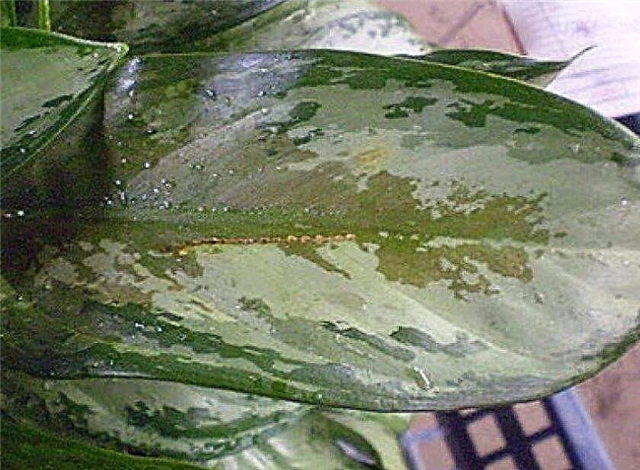
These include:
- Aphids - small insects of green or black color that live on the underside of the leaf and drink juice from it.
- Shield - Covers the leaves with dark spots, and the larvae of the scale insects eat the plant.
- Spider mite - the leaves are covered with a thin white web, on which red bugs are noticeable.
To combat these pests, Dieffenbachia leaves are cleaned of insects with a cotton swab dipped in soapy water. The remaining soap is thoroughly washed off the surface of the sheet with water. If the number of insects is very large, then you can’t do without special tools. In this case, Dieffenbachia is treated with insecticides (Actellik, Fitoverm).
Despite the fact that spotted dieffenbachia belongs to poisonous shrubs, it can often be found at home at many gardeners. If you follow the safety rules in working with the plant and provide it with the described simple care, then spotted dieffenbachia will become a real decoration of any interior.





